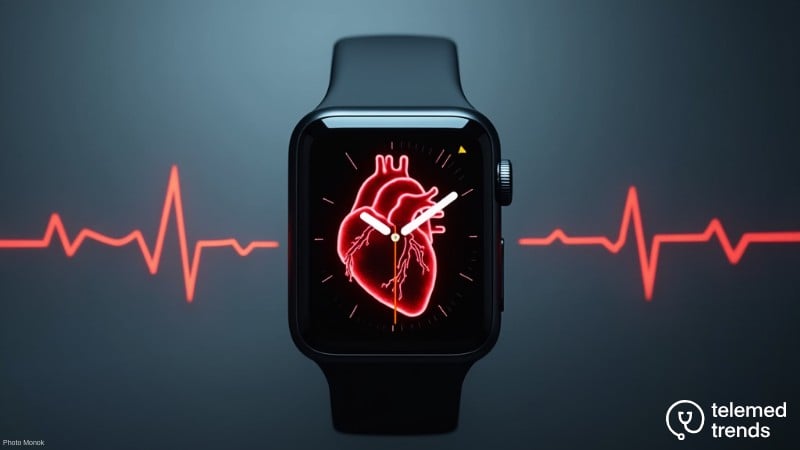Beyond fitness tracking, wearable technology has quickly advanced to become a game-changer in healthcare. Advanced functions that track irregular cardiac rhythms, monitor vital signs, and provide early alerts for possible health hazards are now available in devices like smartwatches.
Atrial fibrillation (AFib), a common cardiac rhythm abnormality linked to an increased risk of stroke, is one chronic condition for which these technical developments are especially important. Since millions of people worldwide suffer from AFib, innovative methods of managing the condition are crucial. To meet this requirement, Northwestern University and Johns Hopkins University collaborated on the Rhythm Evaluation for AntiCoagulaTion (REACT-AF) experiment.
The seven-year project, which is supported by a $37 million grant from the National Heart, Lung, and Blood Institute, investigates a new, individualized therapy approach employing Apple Watch technology to reduce the lifelong reliance on blood-thinning medications. Through an integrated app on the Apple Watch and iPhone, patients can monitor AFib episodes and target anticoagulant use only during high-risk periods, potentially improving patient outcomes and reducing healthcare costs.
Key Takeaways
Wearable technology—especially the Apple Watch—is reshaping healthcare by enabling real-time monitoring of chronic conditions such as atrial fibrillation (AFib) and streamlining patient management.
- The Apple Watch’s heart rhythm monitoring features are being utilized in a seven-year study aimed at reducing the lifelong reliance on blood-thinning medications among AFib patients.
- Wearable technology boosts patient engagement, enhances adherence to medication schedules, and improves communication between patients and healthcare professionals.
- Continuous monitoring via wearables paves the way for early diagnosis of issues like AFib, allowing for prompt interventions and better long-term outcomes.
Wearables in patient health management
Patients’ approaches to managing chronic diseases are being revolutionized by wearable technology, which provides real-time data and ongoing monitoring to enable people to actively participate in their own health. This change is best shown by the REACT-AF trial, which examines how wearable technology can help patients with AFib manage their use of anticoagulants.
In order to prevent strokes, patients have historically relied on ongoing blood thinners; nevertheless, this strategy carries the risk of bleeding and other consequences. Participants can utilize the Apple Watch’s heart rhythm monitoring features to get alerts during extended episodes of AFib, which will help them take their medications on time. In addition to lowering needless exposure to blood thinners, this individualized “pill-in-pocket” approach improves patient involvement in their treatment regimens.
If proven effective, this new treatment paradigm will fundamentally change the standard of care for the millions of Americans living with AFib
Dr. Rod Passman, director of the Center for Arrhythmia Research
Furthermore, case studies on wearables and patient health management show that wearables indeed help with better health care. When given smart gadgets, patients frequently become more conscious of their illness and take proactive steps to improve their lifestyle. The effectiveness of wearables as health management tools is demonstrated by real-world data from users, which shows improved adherence to prescription schedules and follow-up consultations.
Additionally, patients and healthcare professionals may communicate more easily thanks to wearable technology, which makes it possible to share data that helps with well-informed decision-making. The incorporation of personal health data into clinical care highlights wearables’ increasing significance in all-encompassing patient management plans.
Case studies on wearables and prevention
Another area in which wearables are significantly advancing is preventive healthcare. In diseases like AFib, where preventing stroke is crucial, early intervention can dramatically lower the chance of serious health consequences. The REACT-AF trial seeks to show how wearable technology-guided, tailored blood thinner treatment can reduce side effects and stroke risk. Wearables help patients take their medications on time by warning them at high-risk times. This improves preventive care without requiring ongoing care.
Beyond clinical trials, real-world case studies highlight wearables’ preventive advantages. Wearable technology has been used by people to identify irregular heartbeats, which has led to early medical assessment and avoided consequences. For instance, notifications sent by their gadgets helped patients who had previously missed minor symptoms to recognize underlying illnesses. This capacity to record asymptomatic occurrences is essential for averting negative consequences, particularly in groups at high risk.
Wearable technology offers a proactive way to lessen the worldwide burden of cardiovascular illnesses, and as it becomes more widely available, its potential to support extensive preventative health programs keeps expanding.
Case studies on wearables and early diagnosis
For better patient outcomes and efficient treatment, early diagnosis is essential. With their capacity for continuous monitoring, wearable technology is becoming more widely acknowledged for its potential to identify health problems early on.
In order to prevent the progression of AFib and lower the risk of stroke, the REACT-AF study uses the Apple Watch to detect bouts of the condition that could otherwise go unrecognized. This allows for prompt interventions. These gadgets, which record data in real time, provide a non-invasive, easy-to-use tool for early diagnosis. This is especially helpful for people who have asymptomatic or occasional episodes.
Numerous case studies demonstrate the practical effects of wearables-assisted early diagnosis. By rapidly seeking medical attention after receiving notifications for abnormal cardiac rhythms, patients were able to receive earlier diagnoses and more successful treatment strategies. In several instances, wearable device notifications were the only reason people learned about dangerous disorders like AFib or other arrhythmias. Because of this early understanding, life-threatening problems may be avoided with timely medical care.
Truly, increased public awareness and the broad use of wearable technology highlight its growing importance as a vital tool for early detection and better long-term health outcomes. It signals a future where proactive, personalized care becomes the standard, benefiting millions worldwide.






